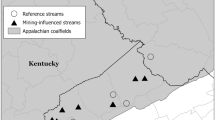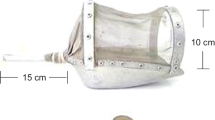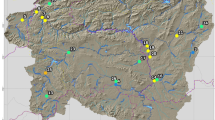Abstract
Significant variations in four biological measures of water quality with stream order and river basin were demonstrated for streams of the Black and Osage river basins of Missouri. Water quality criteria specific for each order and basin were then developed.
Benthic macroinvertebrates from springs and stream orders 3–8 in the two river basins were sampled quarterly for one year with riffle nets and artificial substrate samplers. A total of 548 samples were taken at 137 stations. The average annual macroinvertebrate density, index of diversity, number of taxa, and number of mayfly and stonefly taxa were determined for each station. These measures showed significant differences (p < 0.05) across stream order within and between the two river basins. Total taxa, total mayfly and stonefly taxa, and diversity were highest in orders 4 and 5 with decreased values in lower and higher stream orders. Maximum organism densities occurred in intermediate order streams. These differences were attributed to the succession of physical changes from headwaters to mouth within each river and to the unique geomorphology of each catchment basin.
Water quality criteria based on three of the four measures described above (with 95% confidence limits) were established for each stream order in each river basin. Criteria for the Osage River basin were then used to identify three streams in the basin affected by environmental disturbances (stream impoundment, channelization and sewage discharge). The use of order- and basin-specific criteria assures that the biological differences between streams caused by environmental disturbance can be distinguished from the natural biological differences between streams of different orders and drainages.
Similar content being viewed by others
References
Barila, T. Y., Williams, R. D. & J. R. Stauffer, 1981. The influence of stream order and selected streambed parameters on fish diversity in Rayston Branch, Susquehanna River drainage, Pennsylvania. J.A. Ecol. 18: 125–131.
Barmuta, L. A. & P. S. Lake, 1982. On the value of the river continuum concept. N.Z.J. Mar. Freshwat. Res. 16: 227–229.
Beecher, H. A., E. R. Dott & R. F. Fernan, 1988. Fish species richness and stream order in Washington State streams. Envir. Biol. Fishes 22: 193–209.
Bruns, D. A. & G. W. Minshall, 1984. Seasonal patterns in species diversity and niche parameters of lotic predator guilds. Arch. Hydrobiol. 106: 395–416.
Cummins, K. W., 1974. Structure and function of stream ecosystems. Biol. Sci. 24: 631–641.
Culp, J. M. & R. W. Davies, 1982. Analysis of longitudinal zonation and the river continuum concept in the Oldman — South Saskatchewan River System. Can. J. Fish. aquat Sci. 39: 1258–1266.
Cushing, C. E., C. D. McIntire, K. W. Cummins, G. W. Minshall, R. C. Peterson, L. Sweden, J. R. Sedell & R. L. Vannote, 1983. Relationships among chemical, physical and biological indices along river continua based on multivariate analysis. Arch. Hydrobiol. 98: 317–326.
DeMarch, B. G. E., 1976. Spatial and temporal patterns in macrobenthic stream diversity. J. Fish. Res. Bd Can. 33: 1261–1270.
Dieffenbach, W. H. & F. M. Ryck, 1976. Water quality of the Elk, James, and Spring River basins, 1964–1965. Missouri Department of Conservation Aquatic Series 15, Jefferson City. 25 pp.
Duchrow, R. M., 1977. Water quality of the Current, Jacks Fork, Eleven Point, Little Black and Warm Fork of the Spring rivers, Missouri. Missouri Department of Conservation, Jefferson City, Mo. 80 pp.
Duchrow, R. M., 1984. Water quality of the Osage River Basin. Missouri Department of Conservation, Jefferson City, Mo. 356 pp.
Fisher, S. G., 1977. Organic matter processing by a stream segment ecosystem: Fort River Massachusetts, U.S.A. Int. Revue Hydrobiol. 62: 701–727.
Godfrey, P. J., 1978. Diversity as a measure of benthic macroinvertebrate community response to water pollution. Hydrobiol. 57: 111–122.
Goodnight, C. J., 1973. The use of aquatic macroinvertebrates as indicators of pollution. Trans. Am. Microsc. Soc. 92: 1–7.
Harrel, R. C., B. J. Davis & T. C. Dorris, 1967. Stream order and species diversity of fishes in an intermittent Oklahoma stream. Am. Midl. Nat. 78: 428–436.
Harrel, R. C. & T. C. Dorris, 1968. Stream order, morphometry, physicochemical conditions, and community structure of macroinvertebrates in an intermittent stream. Am. Midl. Nat. 80: 220–250.
Hauer, F. R. & J. A. Stanford, 1982. Ecological response of hydropsychid caddisflies to stream regulation. Can. J. Fish. aquat. Sci. 39: 1235–1242.
Hawkins, C. P. & J. R. Sedell, 1981. Longitudinal and seasonal changes in functional organizations of macroinvertebrate communities in four Oregon streams. Ecology 62: 387–397.
Hilsenhoff, W. L., 1977. Use of arthropods to evaluate water quality of streams. Technical Bulletin No. 100, Department of Natural Resources, Madison, Wisconsin. 15 pp.
Horton, R. E., 1945. Erosional development of streams and their drainages. Bull. Geol. Soc. Am. 56: 275–370.
Hynes, H. B. N., 1960. The biology of polluted waters. Liverpool Univ. Press, Liverpool. 202 pp.
Jones, J. R., B. H. Tracy, J. L. Sebaugh, D. H. Hazelwood & M. M. Smart, 1981. Biotic index tested for ability to assess water quality of Missouri Ozark streams. Trans. am. Fish. Soc. 111: 627–637.
Karr, J. R., 1981. Assessment of biotic integrity using fish communities. Fisheries. 6: 21–27.
Kuehne, R. A., 1962. A classification of streams illustrated by fish distribution in an eastern Kentucky creek. Ecology. 43: 608–614.
Kuester, D. R., 1964. The benthos of the Meramec River Basin as related to water quality. In Water quality in the Big, Bourbeuse, and Meramec River basins. The Department of Public Health and Welfare, Missouri Water Pollution Board, Jefferson City, Mo. 234–240.
Lotspeich, F. B., 1980. Watersheds as the basic ecosystem: this conceptual framework provides a basis for a natural classification system. Wat. Res. Bull. 16: 581–586.
Margalef, R., 1957. La teoria de la informacions en ecologia. Mem. R. Acad. Cienc. Artes Barcelona. 32: 373–449.
Metcalfe, J. L., 1989. Biological water quality assessment of running waters based on macroinvertebrate communities: History and present status in Europe. Envir. Pollut. 60: 101–139.
Minshall, G. W., 1978. Autotrophy in stream ecosystems. Biol. Sci. 28: 767–771.
Minshall, G. W., R. C. Peterson, K. W. Cummins, T. L. Bott, J. R. Sedell, C. E. Cushing & R. L. Vannote, 1983. Interbiome comparison of stream ecosystem dynamics. Ecol. Monogr. 53: 1–25.
Minshall, G. W., K. W. Cummins, R. C. Petersen, C. E. Cushing, D. A. Bruns, J. R. Sedell & R. L. Vannote, 1985a. Developments in stream ecosystem theory. Can. J. Fish. aquat. Sci. 42: 1045–1055.
Minshall, G. W., R. C. Petersen & C. F. Nimz, 1985b. Species richness in streams of different size from the same drainage basin. Am. Nat. 125: 16–38.
Naiman, R.. & J. R. Sedell, 1980. Relationship between metabolic parameters and stream order in Oregon. Can. J. Fish. aquat. Sci. 37: 834–847.
Platts, W. S., 1979. Relationships among stream order, fish populations and aquatic geomorphology in an Idaho river drainage. Fisheries 4: 5–9.
Rabeni, C. F. & G. W. Minshall, 1977. Factors affecting microdistribution of stream benthic insects. Oikos. 29: 33–43.
Resh, V. H. & J. D. Unzicker, 1975. Water quality monitoring and aquatic organisms: the importance of species identification. J. Wat. Pollut. Control Fed. 47: 9–19.
Ross, R. E., 1963. Stream communities and terrestrial biomes. Arch. Hydrobiol. 59: 235–242.
Ryck, F. M., 1974. Water quality of the southeast Ozark mining area, 1965–1971. Missouri Department of Conservation, Aquatic Series 10. 22 pp.
SAS Institute Inc., 1985. SAS users guide: version 5 SAS institute, NC. 1290 pp.
Smart, M. M., 1980. Stream-watershed relationships in the Missouri Ozark Plateau Province. Doctoral dissertation. University of Missouri — Columbia, Columbia, Mo. USA.
Statzner, B. & B. Higler, 1985. Questions and comments on the river continuum concept. Can. J. Fish. aquat. Sci. 42: 1038–1044.
Statzner, B., J. A. Gore & U. H. Resh, 1988. Hydraulic stream ecology: observed patterns and potential applications. J. N. Am. Bentho Soc. 7: 307–360.
Strahler, A. N., 1957. Quantitative analysis of watershed geomorphology. Trans. Am. Geophys. Un. 38: 913–920.
Taylor, B. R. & J. C. Roff, 1982. Evaluation of ecological maturity in three headwater streams. Arch. Hydrobiol. 94: 99–125.
Townsend, C. R. & A. G. Hildrew, 1984. Longitudinal pattern in detritivore communities of acid streams: A consideration of hypothesis. Verh. int. Ver. Limnol. 22: 1953–1958.
U.S. Environmental Protection Agency, 1973. Biological field and laboratory methods measuring the quality of surface effluents. Environmental Monitoring Series EPA-67014–73–001. 1976 pp.
U.S. Environmental Protection Agency, 1989. Rapid bio-assessment protocols for use in streams and rivers: benthic macroinvertebrates and fish. U.S. EPA/444/4–89–1001.
Usinger, R. L., 1963. Aquatic insects of California. Univ. of California Press, Berkeley. 508 pp.
Vannote, R. L., G. W. Minshall, K. W. Cummins, J. R. Sedell & C. E. Cushing, 1980. The river continuum concept. Can. J. Fish. aquat. Sci. 37: 130–137.
Vineyard, J. D. & G. L. Feder, 1974. Springs of Missouri. Missouri Geol. Surv. and Wat. Resour., Rolla, Mo. 267 pp.
Whiteside, B. G. & R. M. McNatt, 1972. Fish species diversity in relation to stream order and physicochemical conditions in the Plum Creek drainage basin. Am. Midl. Nat. 88: 91–101.
Wilhm, J. L., 1967. Comparison of some diversity indices applied to populations of benthic macroinvertebrates in a stream receiving organic wastes. J. Wat. Pollut. Cont. Fed. 39: 1673–1683.
Winterbourn, M. J., B. C. Rounick & B. Cowie, 1981. Are New Zealand stream ecosystems really different? N.Z.J. Mar. Freshwat. Res. 15: 321–328.
Author information
Authors and Affiliations
Rights and permissions
About this article
Cite this article
Crunkilton, R.L., Duchrow, R.M. Use of stream order and biological indices to assess water quality in the Osage and Black river basins of Missouri. Hydrobiologia 224, 155–166 (1991). https://doi.org/10.1007/BF00008465
Received:
Revised:
Issue Date:
DOI: https://doi.org/10.1007/BF00008465




